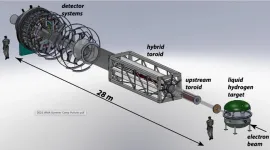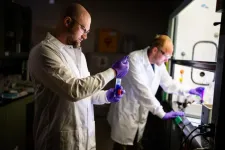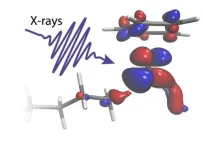After imagining what it would look like for 17 years, Krishna Kumar felt chills the first time he saw fully engineered drawings of the MOLLER experiment.
“Seeing the designs on paper gave me pins and needles,” said Kumar, professor of physics at the University of Massachusetts Amherst and the principal spokesperson for MOLLER, the experiment that will make a Measurement of a Lepton-Lepton Electroweak Reaction.
The MOLLER collaboration formed in 2006, and more than 100 physicists from more than 30 institutions are now involved. Recently, a team of physicists and engineers finished designing all of the equipment for the experiment.
Once built, MOLLER will test physicists’ basic understanding of our world: the Standard Model of physics. This theory describes the fundamental particles and four forces at work in our universe.
The Standard Model predicts a value for the electron’s weak charge, which is essentially how much influence the weak force exerts on the electron. The electron’s weak charge has been measured before, but MOLLER will make a measurement that is five times more precise and compare it to the Standard Model’s prediction.
“We know there are some things wrong with the Standard Model, we’re just not sure what parts and why,” said James “Jim” Fast, the Jefferson Lab project manager for MOLLER. “If there is a difference from what we expect, it’s evidence that our model of physics is broken in some fundamental way.”
A unique accelerator
To measure the electron’s weak charge, MOLLER will use the electron beam at Jefferson Lab’s Continuous Electron Beam Accelerator Facility (CEBAF). The CEBAF particle accelerator will shoot a beam of electrons at electrons in a target. The beam and target electrons interact with each other by both the electromagnetic and weak forces, and the deflected electrons will be directed by magnetic fields into detectors where the scattered flux will be measured.
But the weak force lives up to its name: it’s really weak! So, to be able to measure its influence, the researchers will need to take advantage of a special feature of the weak force.
Particles have a property known as spin. A particle is right-handed if its spin is aligned with its direction of motion, and left-handed if its spin opposes its motion. Fortunately, for the sake of the experiment, left- and right-handed electrons interact via the weak force with different strengths.
The polarization of the electron beam from CEBAF will be rapidly flipped to alternately produce right-handed and left-handed electrons. MOLLER will analyze the difference in electron scattering between the right-handed and left-handed electron polarization states to yield a world-record measurement of the weak force.
However, at around 30 parts per billion, the fractional difference between right- and left-handed electron-electron interaction probabilities is tiny.
“It could be compared to measuring grains of salt in a swimming pool,” said Mike Dion, a senior staff engineer at Jefferson Lab. “We have an electron beam flooded with electrons, and we're smashing that into a big target. And we're interested in very, very few of the interactions that happen.”
CEBAF is an Office of Science user facility that is well suited to make this challenging measurement. For one, it can rapidly flip the polarization of the beam, up to 2,000 times per second, while maintaining high levels of beam polarization, around 80-90%.
“Doing both of those things is very hard to do, so this is a pretty unique facility,” Fast said. “CEBAF is really the only accelerator in the world where you could do this experiment.”
CEBAF is also able to keep the beam stable enough to not drown out the weak signal it’s searching for. When the polarization of a beam is alternating, the beam may shift during the transition. If the beam shifts by even a micrometer, 50 times smaller than a human hair, it could change the final measurement by more than the effect the researchers are trying to measure.
“So, you need to find smart ways to keep the beam the same down to a nanometer, and CEBAF has the capability to do that,” Kumar said.
CEBAF can deliver a continuous stream of electrons (instead of bursts like some accelerators do), which better keeps the beam in place. Because the difference in the left- and right-handed electron-electron interaction rates increases with energy, the high energy of CEBAF’s beam, which will run at 10-11 billon electron-volts (GeV) for this experiment, is also a big advantage.
“If you did this at much lower energy, it would take forever,” Fast explained.
As it is, MOLLER plans to take data for 344 days to ensure it has enough high-quality data to reach its goal.
A stable target
MOLLER needs more than just an accelerator. Some of its elements will be built at Jefferson Lab, whereas others will be constructed at various institutions. But they will all need to fit together perfectly in Jefferson Lab’s Experimental Hall A.
“It's like putting a Boeing 747 together, where different pieces are put together in different parts of the world, and they all come together and fit down to the last bolt,” Kumar said.
The first piece of this very large and complicated puzzle that CEBAF’s electron beam will encounter is a liquid hydrogen target. This is a notoriously challenging type of target, but luckily, Jefferson Lab staff are well versed in its design and construction.
“Jefferson Lab is the world expert on building these complex liquid hydrogen targets,” Kumar said.
To keep the target in a liquid state, it must be cold – around 15 degrees Kelvin (about -433 degrees Fahrenheit). However, when CEBAF’s beam hits the target, it deposits 4,000 watts of power into the liquid, heating it up.
Silviu Covrig Dusa, a staff scientist at Jefferson Lab, is the control account manager for MOLLER’s target.
“From the management point of view, I'm essentially responsible for delivering the target system,” he said.
Covrig Dusa has been using modeling to design the target and test how the beam will affect it. His simulations showed that precisely wiggling the beam around in the target, (without triggering the type of shift in the beam that could happen as its polarization is alternated) is one way to spread the heat around to prevent this liquid from boiling.
At four feet long, the target is also 12 times thicker than typical Jefferson Lab targets, and it’s the thickest hydrogen target yet to be deployed at Jefferson Lab. A thicker target means there are more target electrons for the beam electrons to interact with, which increases the chance of weak interactions.
However, a thicker target also means the beam will deposit more power into it.
“The more power you put in the target, the more noise you generate,” said Covrig Dusa. “We want to minimize the noise of the target.”
That’s because noise, which is the name given to random fluctuations in the data, could drown out the desired signal. The MOLLER team is especially monitoring density fluctuations in the target, for instance, caused by changes in the liquid from heating by the electron beam. This heating can cause a significant amount of noise.
Covrig Dusa is using modeling to predict the amount of noise that will be generated in the target by the beam, and then figure out which target geometry turns down that noise the most.
A focused spectrometer
After the target, the scattered electrons enter MOLLER’s spectrometer, which, at 26 meters long, will take up most of the space in Hall A.
“The spectrometer is the heart of the experiment,” said Juliette Mammei, associate professor at the University of Manitoba and lead physicist for MOLLER’s spectrometer.
The spectrometer will act as a particle shepherd of sorts, ensuring that all the different particles in the experiment go where they are supposed to. It will separate signal electrons, which interacted with electrons in the target, from the background electrons that did not. It will send these signal electrons to the main detector to be measured.
As lead physicist for the spectrometer, Mammei helped figure out its intricate configuration. The device’s completely novel geometry will double the efficiency of MOLLER to collect signal electrons.
“It’s a very clever idea that basically cuts the amount of time they would need in half to run the experiment,” Fast said.
The main way the spectrometer does this is with a series of five donut-shaped magnets that will sort the particles by their energy before focusing them toward their proper destinations.
“Without the magnets, the particles would go everywhere in an uncontrolled shower,” said Dave Kashy, lead engineer for the spectrometer and principal staff engineer at Jefferson Lab.
To design and build this crucial but never-before-constructed device, the team is working closely with the magnet group at Jefferson Lab.
“Jefferson Lab will be building this magnet, and that brings a lot of engineering challenges,” said Probir Ghoshal, the Jefferson Lab magnet group leader and a senior staff engineer.
To conquer these engineering challenges, MOLLER brought on a lot of younger engineers who are fresh out of school.
“This project is a very good learning platform for engineering skills that are not going to be taught at any schools, only at national labs,” Ghosal said.
The team is currently assembling a prototype to make sure the design will work as planned.
“The schedule's optimistic,” said Dion, the control account manager for the spectrometer. “There's not a lot of room for error on an experiment like this.”
Now, with CD-3A in hand, the MOLLER project has a better chance of keeping to its schedule. CD-3A allows the team to begin procuring key components, including toroid magnet coils and associated support system parts, power supplies, beam pipes and bellows, the liquid hydrogen target, and a beam-measuring devices call the polarimeter collimator, with a little padding for any needed contingency.
State-of-the-art detectors
Other determinations are also keeping the project on time. In 2022, MOLLER received $31 million of funding as part of the Inflation Reduction Act (IRA).
“Getting the IRA money was transformational,” Fast said.
This funding will keep the project on schedule by ensuring the experiment can buy necessary materials to build the many important pieces of equipment on time and on budget. Having the money available as the greenlight was given for CD-3A means that the project may move forward apace.
MOLLER also received grants from the Canadian Foundation for Innovation and Research Manitoba for $3.7 million (converted to U.S. dollars). These grants will be used to design and construct ultrasensitive electron detectors that will allow for detailed measurements of the particles that emerge from the electrons’ interactions.
The MOLLER partnership has also been granted additional funding by the National Science Foundation, which contributed almost $6 million for nine universities to build additional detectors to accompany MOLLER’s main detector.
“All of these detectors will allow us to make important corrections to the data,” said Mark Pitt, professor of physics and physics department chair at Virginia Tech. He is deputy spokesperson for MOLLER and project coordinator for the NSF grant.
These corrections, for example, will measure the background electrons, such as beam electrons that interact with protons instead of electrons in the hydrogen target. Measuring background particles and subtracting them from the signal measurement will allow the physicists to correct for systematic errors in the data.
“Our ability to do that correction depends upon how well the apparatus is built and designed,” Pitt said.
The NSF and CFI grants will ensure the detectors are built with state-of-the-art technology.
They’re also partially funding personnel at these universities, including graduate students and postdoctoral fellows. Because the professional timelines of these early-career scientists match up with the timeline of a project like MOLLER, they can be involved in important milestones while learning different skills related to simulating, designing, testing, building and installing detectors and their supports.
“We're looking for new physics, something beyond what we know, and that really gets students and postdocs interested in science and technology,” Pitt said.
Early-career scientists brought on to other elements of MOLLER also have an opportunity to grow with this project.
“We have some really good mid-career and more junior talent that we brought in, which I think is great,” Fast said.
For example, Mammei, who is leading the spectrometer group, joined the collaboration while she was a postdoc in Kumar’s group in 2010. And Pitt had been her thesis advisor. When she joined the MOLLER collaboration, she was already well on her way to becoming their colleague.
“I’m honored to be working with such an excellent group of physicists and engineers pushing the limits of precision of these Standard Model tests,” she said.
Other younger members of the project, who were students or postdocs when it began, are also now running pieces of the experiment.
“It’s very cool to see them develop professionally as MOLLER evolves,” Kumar said. “Projects like MOLLER help young people to become scientists, and that’s what the reward of all this is, apart from hopefully rewriting textbooks.”
Further Reading
Inflation Reduction Act Funding Moves Key Jefferson Lab Projects Forward
Partnership Contributes Toward Sharp Eyes for MOLLER Experiment
Particle Physicist Takes the Lead on Groundbreaking Electron Measurement
Experiment to Precisely Measure Electrons Moves Forward
As a Matter of Fact, They Do Sweat the Small Stuff
The MOLLER Experiment
By Chris Patrick
-end-
Jefferson Science Associates, LLC, manages and operates the Thomas Jefferson National Accelerator Facility, or Jefferson Lab, for the U.S. Department of Energy's Office of Science. JSA is a wholly owned subsidiary of the Southeastern Universities Research Association, Inc. (SURA).
DOE’s Office of Science is the single largest supporter of basic research in the physical sciences in the United States and is working to address some of the most pressing challenges of our time. For more information, visit https://energy.gov/science
END






